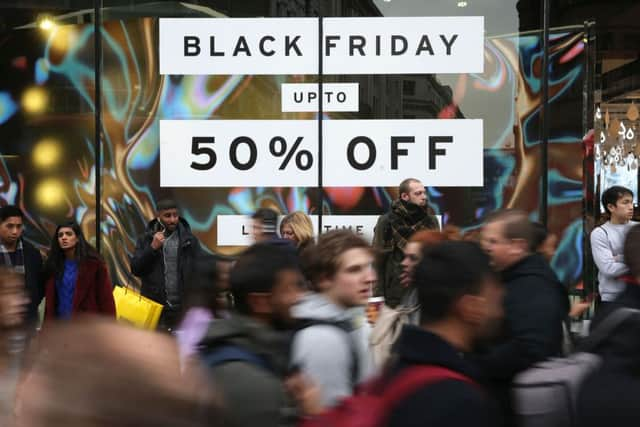Peter Alderdice: Celebrate improved choices and control at the checkout


Over the four days from Black Friday to Cyber Monday, British shoppers are forecast to spend an astounding £8.57 billion, according to a report by the Centre for Retail Research for VoucherCodes.co.uk, an increase of 3.4 per cent on the 2018 figure.
The Black Friday shopping spree, which kicks off on the day after the annual celebration of Thanksgiving in the United States, can be make-or-break for retailers.
Advertisement
Hide AdAdvertisement
Hide AdRecent years have seen a spate of high street businesses collapsing and calling in the administrators over the New Year period, following poor performance in pre-Christmas sales.


Marketing campaigns and heavy discounting have typically been the tools deployed by both high street and online stores to attract custom, but giving consumers greater choice on how to pay at the checkout is increasingly seen as an alternative way to convert footfall into sales.
When it comes to paying for big-ticket purchases, a growing number of consumers are eschewing plastic cards and looking for the flexibility to pay in instalments.
Of course, there is nothing new about the concept of a “buy now, pay later” deal. Instalment plans have been a staple means of financing consumer goods since at least the middle of the last century. However, their popularity waned as credit card usage took off among UK shoppers.
The problem with the instalment plans historically offered by retailers was that customers typically had to complete a credit application form at the till and then wait nervously to find whether their credit application had been approved or whether they would suffer the public indignity of being told credit had been declined.
By contrast, with a credit card, consumers have a widely accepted means of payment and a pre-agreed credit limit. A customer wishing to make a large purchase at a retailer with a credit card knows in advance exactly how much they can spend.
Innovations in financial technology (fintech) are now yielding solutions to the drawbacks of the old instalment plan model, through “point of sale” (POS) finance – a lending solution that allows a customer to access credit from one or more lenders when completing their purchase at a retailer.
In an online context, a POS financing solution enables a retailer to offer a customer at the checkout the option of either paying by card or obtaining an instant online loan. For in-store transactions, similar app-based at-till solutions are available.
Advertisement
Hide AdAdvertisement
Hide AdThe POS finance platform may offer loans from a specific lender, or even allow a customer to compare and select from a range of available instalment plans offered by multiple different lenders.
The benefits to the customer are the ability to complete a credit application online, in seconds and without the nervous wait at the retailer’s cash desk, along with greater control over the profile of the instalment payments.
Research published by IT consultancy firm Forrester earlier this year found POS finance can increase sales by an average of 17 per cent.
The retailer also benefits because although the customer pays in instalments, the lender providing the POS finance pays the retailer straight away.
With the level of personal borrowing continuing to rise in the UK, ease of access to credit can lead to problems. In the first half of 2019 alone, a record 331,337 people contacted the debt charity StepChange for help with problem debt.
In the UK, consumer credit lending is regulated by the Financial Conduct Authority (FCA) and navigating a course through the fiendishly complicated rules on consumer loans can present a challenge for retailers wishing to make POS finance available to their customers. Buy now, pay later deals and credit broking have been the subject of particular scrutiny by the FCA of late.
Some providers of POS finance structure their offering to satisfy exemptions set out in consumer credit legislation, such that they fall outside the FCA’s regulatory perimeter.
However, retailers who introduce their customers to loan providers, could inadvertently find themselves carrying on the regulated activity of credit broking, if the type of loans being offered do not satisfy the detailed, technical requirements for exempt lending. Despite the regulatory challenges, a report by London-based consultancy Apex Insight in 2017 already put the annual figure for POS lending in the UK at £4bn.
Advertisement
Hide AdAdvertisement
Hide AdThe demands of an increasingly tech-savvy public for choice and control at the checkout mean growth in POS finance is likely to continue.
Peter Alderdice is a Senior Associate with Shepherd and Wedderburn